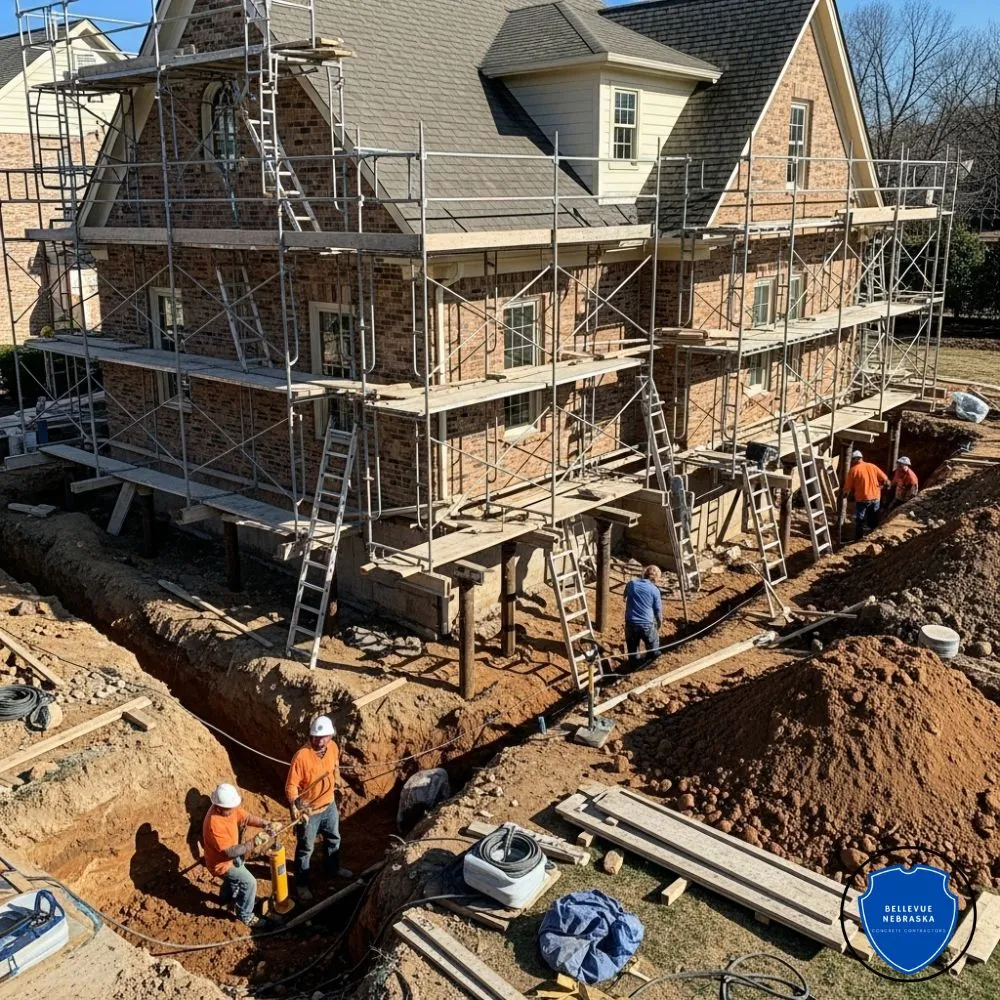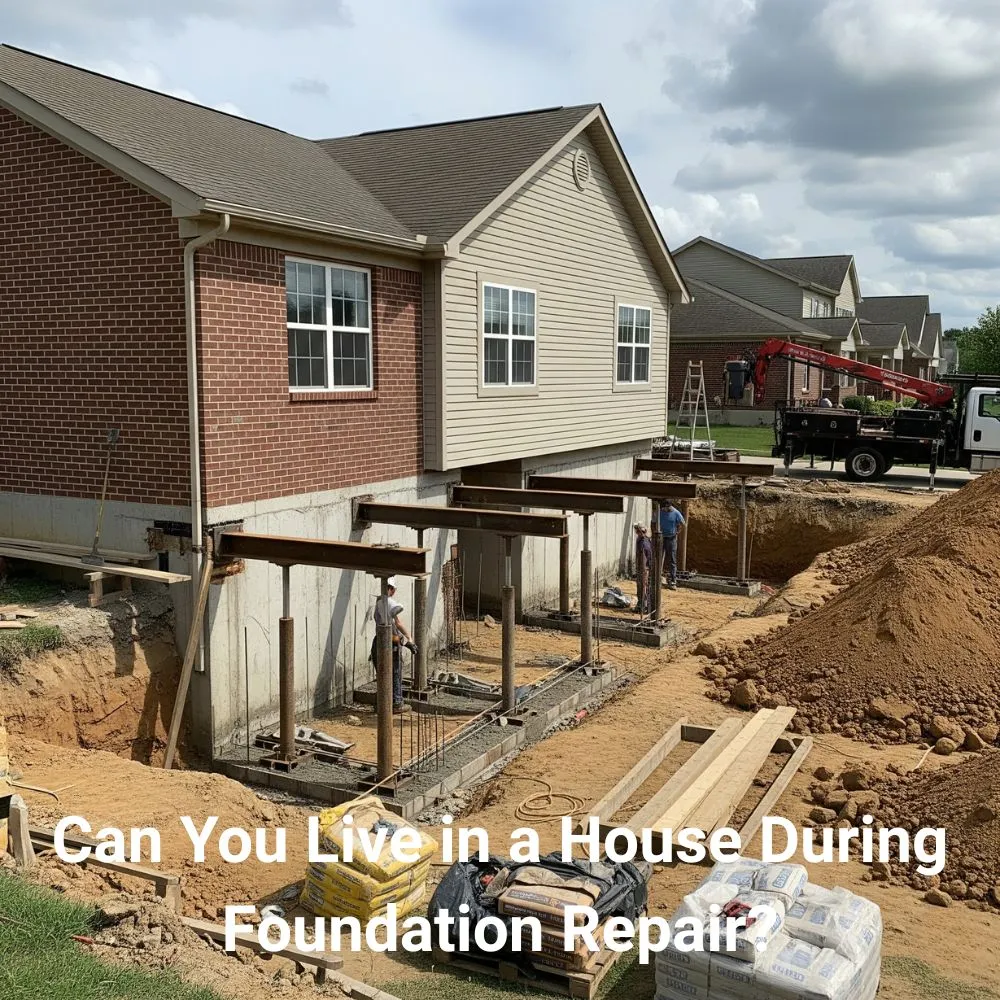Your concrete driveway may crack due to several factors, such as poor drainage, improper curing, or soil movement beneath the surface. Issues during the installation process or exposure to extreme weather conditions can lead to the formation of cracks over time.
Other causes include excessive weight, tree roots growing underneath, or poor drainage around the driveway. In the next sections, we’ll explore the key reasons behind these cracks and what contributes to them over time.
1. Poor Foundation and Base Installation
A concrete driveway needs a strong foundation to remain durable. If the base is not prepared correctly, the soil underneath can shift, causing cracks to form. Weak or improperly compacted soil, along with inadequate gravel layering, leads to instability, making the driveway more prone to damage over time.
How to prevent:
- Ensure proper soil compaction before pouring concrete.
- Use a well-graded gravel base to support the concrete.
- Avoid pouring concrete on soft or wet soil.
- Allow the base to settle before laying the concrete.
To prevent your driveway from a poor foundation and base installation and cracking, you can get help from BellevueNebraskaConcreteContractors. We are the most trusted concrete driveway contractor in Bellevue, Nebraska.
2. Concrete Shrinkage Issues
Concrete naturally shrinks as it dries, but excessive shrinkage can lead to cracks in your driveway. It usually happens due to rapid moisture loss, poor curing conditions, or an improper water-to-cement ratio. If the shrinkage is uneven, the concrete will develop cracks as it contracts.
How to prevent:
- Keep the surface moist during the curing process.
- Apply curing compounds or covers to slow moisture loss.
- Avoid pouring concrete in extreme heat or dry conditions.
- Use control joints to manage shrinkage stress.
3. Curing Condition Effects
Proper curing is essential to prevent cracks in your concrete driveway. If the concrete dries too quickly or unevenly, it becomes weak and prone to cracking. Temperature, humidity, and moisture levels play a crucial role in ensuring the concrete sets correctly.
How to prevent:
- Keep the concrete moist for at least a week after pouring.
- Use curing blankets or plastic sheets to slow water loss.
- Avoid pouring concrete in extreme temperatures.
- Apply curing compounds to retain moisture.
- Ensure even hydration for consistent strength.
4. Improper Mix Proportion Problems
A concrete mix with incorrect proportions can weaken the driveway. Too much water makes the concrete weak, while too little can cause poor workability and cracks. If aggregates, cement, or additives are not balanced, the final surface may become brittle or uneven.
How to prevent:
- Follow the recommended water-to-cement ratio.
- Use high-quality materials for durability.
- Ensure proper mixing to distribute ingredients evenly.
- Avoid adding excess water to make pouring easier.
5. Soil Settlement Impact
The soil beneath your driveway can shift over time, leading to cracks. It usually happens due to improper compaction, water erosion, or natural ground movement. As the soil settles, the concrete above it loses support, causing it to crack or sink.
How to prevent:
- Ensure the soil is properly compacted before pouring concrete.
- Use a stable gravel base to support the driveway.
- Improve drainage to prevent water from washing away soil.
- Avoid building over loose or expansive soil.
- Conduct a soil test to determine stability before construction.
6. Settling Crack Formation
Settling cracks occur when the ground underneath the driveway shifts after installation. It happens when the base isn’t compacted properly or water causes soil movement. These cracks usually appear as deep, uneven fractures in the concrete.
How to prevent:
- Compact the base soil thoroughly before pouring concrete.
- Use crushed stone or gravel for better support.
- Ensure proper drainage to prevent soil erosion.
- Avoid heavy loads on new concrete until fully cured.
- Monitor soil conditions before installation.
7. Excessive Weight Damage
Concrete driveways are strong, but they have weight limits. Heavy vehicles, machinery, or repeated overloading can stress the concrete and cause cracks over time. Driveways with thinner slabs or weak bases are more susceptible to damage.
How to prevent:
- Use thicker concrete slabs for driveways that handle heavy loads.
- Reinforce concrete with steel mesh or rebar.
- Park heavy vehicles in designated areas with proper support.
- Avoid frequent or prolonged exposure to excessive weight.
- Choose high-strength concrete for better load-bearing capacity.
8. Tree Root Growth Effects
Tree roots can grow under your driveway, pushing up the concrete and causing cracks. As roots expand, they create pressure, making the surface uneven and leading to significant structural damage over time.
How to prevent:
- Avoid planting large trees too close to your driveway.
- Use root barriers to direct tree growth away from the driveway.
- Regularly trim tree roots near the concrete.
- Choose tree species with non-invasive root systems.
- Consider flexible concrete solutions in areas prone to root growth.
9. Sharp Object Damage Risks
Sharp objects, such as heavy tools, metal stands, or certain machinery, can scratch or chip your concrete driveway. These small damages may seem minor but can expand into larger cracks over time, especially with exposure to water and temperature changes.
How to prevent:
- Avoid dragging heavy or sharp objects across the driveway.
- Use protective mats under equipment with metal stands.
- Repair small chips before they turn into larger cracks.
- Be cautious when using tools or machinery on the surface.
- Opt for a concrete sealant to add an extra layer of protection.
10. Weather Change Impact
Fluctuating weather conditions can weaken concrete over time. Extreme heat can cause expansion, while cold temperatures can lead to contraction. In freezing conditions, water seeps into cracks, expands, and worsens the damage.
How to prevent:
- Use air-entrained concrete for better freeze-thaw resistance.
- Seal the driveway to prevent water infiltration.
- Avoid using salt-based deicers in winter.
- Provide proper drainage to reduce standing water.
- Repair minor cracks before winter to prevent expansion.
11. Poor Drainage Consequences
Water is one of the biggest threats to a concrete driveway. If water pools on the surface or seeps underneath, it can weaken the base, cause erosion, and lead to cracking. Poor drainage can also make small cracks expand faster.
How to prevent:
- Ensure proper slope and grading for water runoff.
- Install drainage systems to prevent water buildup.
- Keep gutters and downspouts directed away from the driveway.
- Fill in low spots where water tends to collect.
- Seal the concrete to minimize water penetration.
Conclusion
When built correctly, a concrete driveway can stay in excellent condition for a long time. Proper base preparation, well-balanced concrete mix, and correct curing help prevent cracks. Managing environmental factors like weather changes, soil movement, and water drainage is crucial for ensuring long-term durability.
For the best concrete solutions in Bellevue, Nebraska, we are the team you can trust. Our expertise guarantees a high-quality driveway built to last. Reach out to us today, and let’s create a firm and crack-resistant surface for your home!
Frequently Asked Questions
Are small cracks in my driveway a cause for concern?
Small cracks are common and typically not a major concern. However, if they continue to expand, it’s important to address the underlying cause to prevent more severe damage.
What can I do if my concrete driveway has large cracks?
If you notice large cracks, it’s crucial to get professional help for repair. Significant cracks could indicate issues like improper installation or settling soil.
How long will it take for cracks to appear on my concrete driveway?
If the driveway is not installed correctly or exposed to extreme weather conditions, cracks can appear within the first few years.



